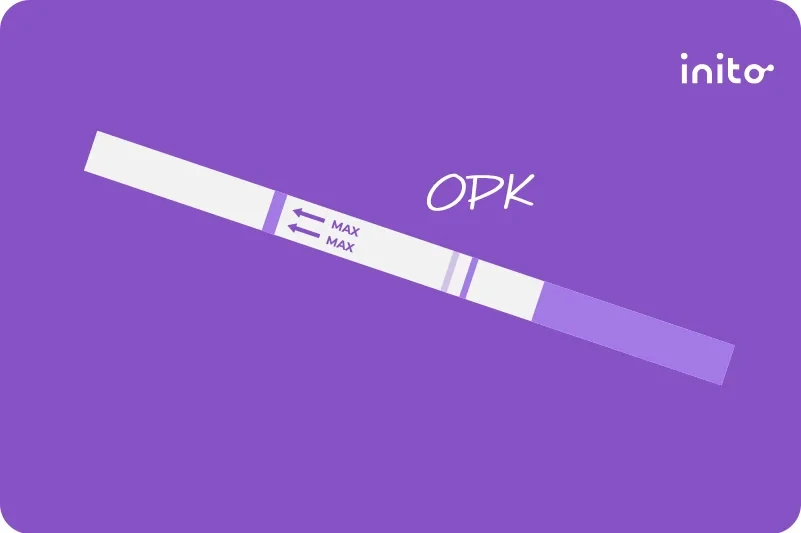Content table
Curious about estrogen and fertility? When you think of estrogen, you probably think “Oh, that’s the female hormone!” And yes, estrogen plays a huge role in your reproductive system. But that’s not the whole story!
Estrogen affects so many bodily functions. These include bone health, brain health, reproduction, cardiovascular system, and more.
But let’s dive more deeply into the nitty gritty of how this hormone affects your ability to conceive.
Keep reading to learn all about high vs. low estrogen symptoms and how estrogen affects fertility.
Key Takeaways
- Estrogen is a hormone that is naturally produced in the human body.
- Estrogen levels vary depending on your age and the time of your cycle.
- Certain lifestyle factors, medications, and medical conditions are associated with high or low levels of estrogen.
- Estrogen imbalances–either too high or too low–can cause health issues and fertility challenges.
- Estrogen and progesterone work in tandem for many reproductive processes. It is important that they are in balance with each other.
- There are many natural ways that you can either increase or decrease your estrogen levels. But talk to your doctor about your estrogen concerns and to get your levels tested.
Normal Estrogen Levels
Before we understand high vs. low estrogen, we’ll need to know the typical estrogen levels women have. Here’s range of estrogen levels in blood at different times in your menstrual cycle.
Two quick “sciencey” things you should know! Estrogen levels are measured in picograms per milliliter. A picogram is one trillionth of a gram.
During your menstrual cycle | between 30 – 800 pg/ml |
During pregnancy | up to 20,000 pg/ml |
After menopause | less than 20 pg/ml |
And just FYI, men have estrogen, too. Regardless of their age, their levels are usually below 40 pg/ml.
Your estrogen levels will vary throughout your cycle. And they are at their highest during pregnancy. This is because estrogen plays a huge role during reproduction. But during your typical menstrual cycle, levels can change quite a bit.
And what is “normal” for one woman won’t be quite the same for another. So, just keep that in mind. Try not to get bogged down when comparing your baseline to others.
Estrogen and Ovulation
Estrogen is a key player in ovulation. During the follicular phase, higher estrogen levels help the dominant egg mature. Once you ovulate, your estrogen levels will fall again.
Estrogen levels must be in the right range for your ovary to release an egg. If you have estrogen dominance or low estrogen, you may have anovulatory cycles. This means that you don’t release an egg that cycle. So if your estrogen levels are out of whack, you may really struggle to conceive.
Estrogen and Fertility
During the luteal phase of your cycle, your estrogen levels will rise while your uterus gets ready for implantation and pregnancy. If you conceive during the first ten weeks of gestation, estrogen levels will keep rising. They usually reach their peak in the third trimester.
First, estrogen is produced in the ovaries. Then, after implantation, the placenta forms and begins producing estrogen, progesterone, and the pregnancy hormone hCG (human chorionic gonadotropin). Once you deliver your baby, your hCG, estrogen, and progesterone levels drop significantly.
Estrogen also plays a vital role in uterine receptivity for successful implantation. Typically, there is about a one-day window where the uterus is at its prime estrogen levels for the embryo to implant properly into the uterine lining.
One study found that the ideal range of estrogen levels for implantation is 3.0 – 25 ng (nanograms) in a progesterone-primed uterus.
If your estrogen levels are too high, this causes the uterus to be in a refractive state instead of a receptive state. This will lead to failed implantation.
Many people don’t know this, but your placenta isn’t the only organ that produces estrogen during pregnancy. Your ovaries, liver, muscle, bone, and brain also secrete small amounts of the hormone. So your estrogen levels could be too high simply because you have a hormonal imbalance.
Estrogen and Progesterone
When it comes to your hormones and fertility, balance is key. This is especially true of the relationship between estrogen and progesterone. Both of these hormones impact the implantation window and receptivity of your uterus to an embryo.
Excess estrogen can throw off the estrogen-to-progesterone ratio. This is called estrogen dominance. When these two hormones are imbalanced, it can harm fertility.
The bright side is this balance can be mimicked with modern medical advancements. One study found that a combination dosage of estradiol (100 ng) and progesterone (500 µg) decreased implantation failure in mammals.
Researchers have worked to find the best ratio for successful implantation. But due to limitations, much of the data is inconclusive. One study did find that a progesterone to estradiol ratio less than 0.25 was associated with adverse pregnancy outcomes for patients undergoing IVF.
High Estrogen and Fertility
There are a lot of factors that could play into having higher amounts of estrogen in your body. Some include diet, lifestyle, and certain medications and medical conditions.
How Do I Know if I Have High or Low Estrogen?
The only way to know for sure is to do a test. There are several tests to check estrogen levels: blood, urine, and even saliva.
You can get a test done by your doctor to detect abnormal estrogen levels. However, the most convenient way is to self-test your estrogen levels with Inito’s fertility monitor.
Inito tests all four fertility hormones: luteinizing hormone, follicle-stimulating hormone, PdG (urine metabolite of progesterone), and estrogen. It helps you track your fertile window and confirm ovulation. High or low levels of estrogen can throw off ovulation, and hence, the Inito fertility monitor will help you track and confirm ovulation with ease.
High Estrogen vs. Low Estrogen Symptoms
If you try to diagnose yourself on symptoms alone, you may struggle. That’s because some of the symptoms for low estrogen are the same as the symptoms for high estrogen.
But here is a rundown of what you may experience if you have an imbalance in estrogen levels:
Estrogen imbalance (high or low) |
Low Estrogen Levels |
High Estrogen Levels |
|
Fatigue Weight gain Moodiness Headaches Low sex drive Breast tenderness |
Issues with concentration Weak/brittle bones Dry skin Hot flashes and night sweats Irregular period, or amenorrhea (no periods) Vaginal dryness |
Unusually heavy or light periods Irregular periods More severe PMS symptoms Bloating Fibrocystic lumps in your breasts Hair loss Trouble sleeping Memory problems |
How Can You Manage Your Estrogen Levels?
Thankfully, you can balance your estrogen levels in quite a few ways. Some are more invasive than others.
Keep reading below for steps you can take to manage your estrogen levels.
Maintain a healthy weight
Consuming a healthy diet and maintaining a healthy weight help manage estrogen levels. Keeping a healthy weight also just helps with overall well-being and fertility.
To manage your weight, consider doing the following:
- Switch to a vegetarian or Mediterranean diet
- Consume isoflavones like soy and flaxseeds
- Choose cruciferous vegetables like kale and broccoli
- Consume more fiber and anti-inflammatory foods like ginger
- Take a liver-supporting supplement like milk thistle
- Increase omega-3 fatty acid intake
Adopt healthy habits
Healthy habits like getting enough sleep and reducing stress also help maintain an estrogen balance. Too much stress can increase cortisol levels, which in turn can decrease estrogen levels.
To manage stress levels, practice mindfulness, yoga, deep breathing, and moderate exercise. Not getting enough sleep consistently also elevates your stress and cortisol levels. So make it a priority to get a good night’s rest whenever possible.
Avoid harmful substances
Avoid consuming alcohol when you are trying to conceive, as this can lead to weight gain and stress. And do your best to stay away from xenoestrogens (synthetic estrogens). These chemicals mimic estrogen in the body, causing estrogen levels to increase unnaturally.
Xenoestrogens are found in many plastics and cosmetic products (like shampoos). Any of the following on food labels could indicate the presence of xenoestrogens: phthalates, BPA, PBC, and parabens. Check the labels on your foods and cosmetics for these chemicals.
Supplementation/hormone replacement therapy
Some of the natural balancing remedies outlined above may work for you. But you can also talk to your doctor about medical supplements and treatments.
The following can be used to help with managing high estrogen levels:
- (GnRH) Gonadotropin-releasing hormone agonists: These stop your ovaries from secreting estrogen.
- Aromatase inhibitors: These not only help treat breast cancer, but they also keep fat cells from releasing estrogen.
If you need additional treatment for low estrogen levels, your doctor may have you consider hormone replacement therapy.
This approach is still controversial. Some believe it can increase the risk of breast cancer and heart disease. However, the FDA does approve the use of estrogens for symptoms of menopause.
One study found that for patients with Premature Ovarian Insufficiency (POI), pre-treatment with estrogen led to successful conception. They also found that estrogen treatment yielded better IVF outcomes.

FAQs
While high or low estrogen levels can impact the way you feel physically, the only way you can tell for sure is by getting your levels tested. The most common estrogen tests are a blood test or a urine test.
Your estrogen levels naturally fluctuate at certain times in your menstrual cycle, so one isn’t necessarily better than the other. If your estrogen is too high or too low when it shouldn’t be, it can cause unwanted symptoms. In other words, an imbalance one way or the other isn’t a good thing.
Symptoms, like fatigue, moodiness, and low sex drive, can be caused by either high or low estrogen. But a few symptoms that are typically associated just with high estrogen are:
- Unusually heavy or light periods
- Irregular periods
- More severe PMS symptoms
- Bloating
- Fibrocystic lumps in your breasts
- Hair loss
- Trouble sleeping
- Memory problems
Women with PCOS could have either high estrogen or low estrogen levels. Some may even have completely normal estrogen levels. That said, across the board, many women with PCOS have estrogen dominance (meaning that their estrogen to progesterone ratio is higher than normal).
Was this article helpful?
- Estrogen treatment in infertile women with premature ovarian insufficiency in transitional phase: a retrospective analysis
- https://www.pnas.org/doi/epdf/10.1073/pnas.0530162100Uterine receptivity for blastocyst implantation
- Effect of Soy and Soy Isoflavones on Obesity-Related Anthropometric Measures: A Systematic Review and Meta-analysis of Randomized Controlled Clinical Trials – ScienceDirect
- Measurement of Estradiol—Challenges Ahead | The Journal of Clinical Endocrinology & Metabolism | Oxford Academic
- Review article Interactions between sleep, stress, and metabolism: From physiological to pathological conditions
- Risks and benefits of estrogen plus progestin in healthy postmenopausal women: principal results From the Women’s Health Initiative randomized controlled trial
- Estrogen–progesterone balance in the context of blastocyst implantation failure induced by predator stress – ScienceDirect












